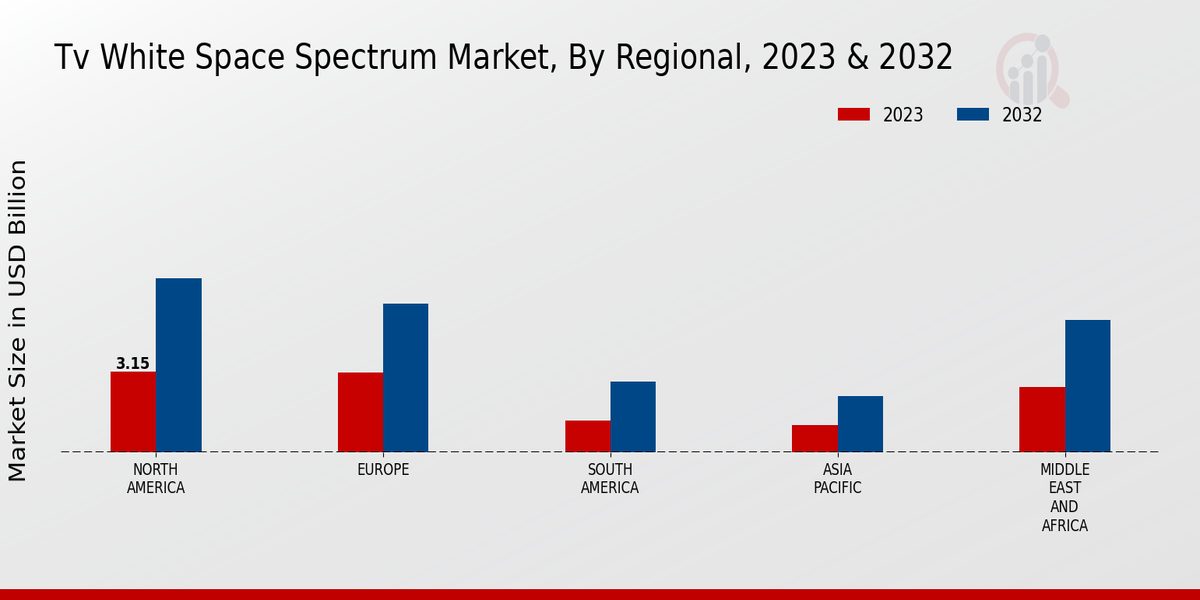Market Growth Projections
The Global TV White Space Spectrum Market Industry is poised for substantial growth, with projections indicating a market value of 10.5 USD Billion by 2035. This growth is underpinned by a compound annual growth rate of 8.84% from 2025 to 2035, reflecting increasing investments in broadband infrastructure and technological advancements. The expansion of internet services in underserved areas, coupled with supportive regulatory frameworks, is likely to drive demand for TV white space solutions. As the market evolves, stakeholders are expected to capitalize on emerging opportunities, further enhancing the industry's landscape.
Regulatory Support and Frameworks
Regulatory bodies worldwide are increasingly recognizing the potential of TV white space technology, which bolsters the Global TV White Space Spectrum Market Industry. Governments are establishing frameworks that facilitate the use of these frequencies for broadband services, thereby promoting innovation and investment. For instance, the Federal Communications Commission in the United States has implemented rules that encourage the deployment of TV white space devices. This regulatory support not only enhances market confidence but also stimulates growth, as companies are more likely to invest in technologies that have clear legal backing. Such initiatives are expected to play a crucial role in shaping the market landscape.
Growing Demand for Internet Connectivity
The increasing demand for reliable internet connectivity across urban and rural areas drives the Global TV White Space Spectrum Market Industry. As of 2024, the market is valued at 4.14 USD Billion, reflecting a significant need for innovative solutions to bridge the digital divide. TV white space technology utilizes unused broadcasting frequencies to provide internet access in underserved regions, thereby enhancing connectivity. This demand is particularly pronounced in developing countries, where traditional broadband infrastructure is lacking. The potential for expanding internet access through TV white space is likely to contribute to the market's growth trajectory.
Rising Investments in Smart City Initiatives
The rise of smart city initiatives globally is a significant driver for the Global TV White Space Spectrum Market Industry. As cities strive to enhance urban living through technology, the demand for reliable and widespread internet connectivity becomes paramount. TV white space technology offers a viable solution for connecting various smart devices and services, facilitating efficient urban management. With projections indicating that the market will reach 10.5 USD Billion by 2035, investments in smart city projects are likely to accelerate the adoption of TV white space solutions. This trend underscores the importance of integrating advanced communication technologies into urban planning.
Increasing Focus on Rural Connectivity Solutions
The Global TV White Space Spectrum Market Industry is significantly influenced by the increasing focus on rural connectivity solutions. Governments and organizations are recognizing the importance of providing internet access to rural populations, which often face challenges in obtaining reliable connectivity. TV white space technology presents a unique opportunity to address these challenges by utilizing unused television frequencies to deliver broadband services in remote areas. This focus on rural connectivity is expected to drive market growth, particularly as initiatives aimed at improving digital inclusion gain momentum. The anticipated compound annual growth rate of 8.84% from 2025 to 2035 highlights the potential for expansion in this sector.
Technological Advancements in Spectrum Management
Technological advancements in spectrum management are pivotal for the Global TV White Space Spectrum Market Industry. Innovations such as dynamic spectrum access and cognitive radio technologies enable more efficient use of available frequencies, thereby maximizing the potential of TV white space. These advancements allow for real-time monitoring and allocation of spectrum resources, which is essential for optimizing network performance. As technology continues to evolve, the market is likely to witness increased adoption of these sophisticated solutions, further driving growth. The integration of advanced technologies could potentially lead to a more robust and resilient communication infrastructure.
























